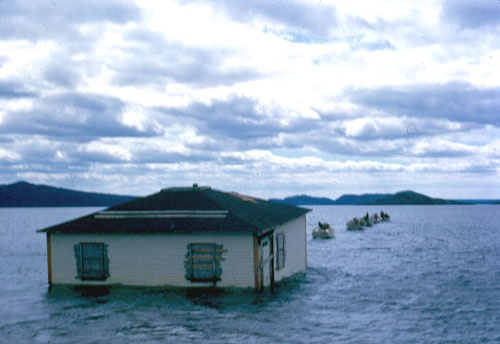
Journeys at the CCA: The Architecture of Migration
A new exhibit at the Canadian Centre for Architecture examines how global movement has reshaped our world.
Moving a house in Trinity Bay, Newfoundland, ca. 1968. Photo: Marilyn Marsh.
Resettlement Collection, Maritime History Archive, Memorial University, PF-317.045.
Migration is not a new idea. You can see evidence of global movement everywhere around you, from the Jamaica-grown banana in your cereal to the divisive immigration debates currently taking place in Arizona and Germany. But we rarely move beyond seeing migration through the lens of how it affects people, which is why the newest exhibit at the Canadian Centre for Architecture (CCA) is so interesting. Called Journeys: How travelling fruit, ideas and buildings rearrange our environment, the exhibit documents the myriad ways in which all types of migration—of people, goods, ideas and more—have changed the physical, visual and social landscapes of our world.
Beautifully designed, like everything at the CCA, Journeys is composed of text, architectural drawings and models, photographs, video, and historical documents.
The exhibit is organized into fifteen narratives, each of which deals with a different facet of migration. Together, they successfully examine not only migration's effects, but also its causes. In the case of the narrative called "Configuration," this means explaining how collapsing fish stocks and the difficulty of providing social services to far-flung communities led the Newfoundland governments of the fifties, sixties and seventies to adopt a policy that favoured the relocation of remote communities to more centralized areas. Practically, that meant that in order to move, thousands of people literally dragged their homes over ice or towed them by sea (it was cheaper than purchasing expensive new homes), dramatically altering Newfoundland's built landscape.
Journeys also does a good job of reminding the viewer that migration is often caused by more than just social forces, as in "Wayfinding," a narrative about how the Inuit's deep knowledge of sea ice, currents, and wind patterns influences their movements across the Northern landscape. It also raises questions about the vulnerability of such established migration patterns. What effects will climate change have on Inuit wayfinding, for instance?
But perhaps the most interesting narratives presented in the exhibition are the ones that have to do with money and economic migration. One of these is "Cycle," which focuses on the constant movement of temporary workers from Senegal in and out of Italy's informal economy. Often, a Senegalese family will send one member at a time to spend three to five years working in the underground economy in Italy. After that time is up, the next family member will go and trade places with the original migrant. In the middle of all this, the immigrants send money and goods back to Senegal; the estimated $400 million per year that these immigrants send home finance development projects that have concrete effects on the country's economic development. Similarly, the "Negotiation" segment of the exhibition illustrates how, after being ravaged by civil war, the government of the Republic of Congo traded natural resource concessions to China in return for a massive economic development package that is radically altering the country's built landscape, as well having potentially devastating effects on the state of its environment.
As more and more of us turn to migration as a permanent reality—CCA Director Mirko Zardini says that "forecasts for the coming decades indicate that migrations may eventually involve as many as a billion people"—it's all the more important that we look closely at the context within which migration can be understood. Journeys does just that: examines the many aspects of migration in a way that is new and necessary.
Journeys is on display at the Canadian Centre for Architecture (1920 Baile) through March 13, 2011. For more information visit cca.qc.ca.
Homepage photo: Pulling a house across the ice at Cook’s Harbour, Great Northern Peninsula, Newfoundland, 1953,
Resettlement Collection, Maritime History Archive, Memorial University.
Related on maisonneuve.org:
—Exploring Outer Space Through Architecture
—The Composer Who Used Coloured Pencils
—Hey! Pay Attention
Subscribe — Follow Maisy on Twitter — Like Maisy on Facebook





